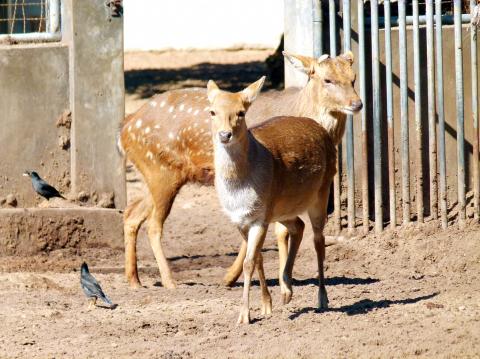Formosan sika deer (Cervus nippon taioanus) raised in captivity at the Kinmen Livestock Research Institute may be the most genetically similar yet to their extinct wild cousins, National Taiwan University researcher Ju Yu-ten (朱有田) said.
The Kinmen Livestock Research Institute commissioned Ju, an associate professor at the university’s Department of Animal Science and Technology, to conduct research on the institute’s Formosan sika deer breeding program as part of an effort to promote tourism to the island chain and set a good example of environmental conservation.
Presenting his findings on Friday, Ju said that compared with the deer raised at Kenting National Park, the animals bred in Kinmen had a “purer” genetic makeup that showed a continuity with the genetic structure of the original wild Formosan sika deer.

Photo: CNA
Ju said that he had arrived at this conclusion after comparing the genetic material of the deer raised in Kinmen and Kenting with material gleaned from the tooth of a Formosan sika deer unearthed at an archeological dig.
The Formosan sika deer is a subspecies endemic to Taiwan, but all wild Formosan sika are extinct due to extensive hunting of the animal during the era of Dutch colonization and during the modernization undertaken by the Japanese colonial government, Ju said. All surviving specimens of the Formosan subspecies have been raised in captivity and then introduced into the wild, he added.
Ju said that the current stock of deer raised in captivity were not genetically pure, because those that were genetically closest to the wild Formosan sika deer — which were raised at the Taipei Zoo in the 1980s — had to be put down en masse after the group was infected with tuberculosis.
Kenting and Kinmen both received deer from Taipei Zoo prior to the outbreak, but while Kenting National Park introduced other subspecies of deer to its population, the Kinmen Livestock Research Institute kept its Formosan sika deer separate from others.
This separation, coupled with the geographic isolation of Kinmen, has made inter-breeding with other species nearly impossible, which is what has made the Kinmen sika deer the most “Aboriginal” of their kind, Ju said.
Meanwhile, institute director Wen Shuei-cheng (文水成) said that the facility has also developed a drink made from the deer’s antlers. Wen said the insitute aimed to use the drink in addition to the deer program to promote tourism to Kinmen.

Three Taiwanese airlines have prohibited passengers from packing Bluetooth earbuds and their charger cases in checked luggage. EVA Air and Uni Air said that Bluetooth earbuds and charger cases are categorized as portable electronic devices, which should be switched off if they are placed in checked luggage based on international aviation safety regulations. They must not be in standby or sleep mode. However, as charging would continue when earbuds are placed in the charger cases, which would contravene international aviation regulations, their cases must be carried as hand luggage, they said. Tigerair Taiwan said that earbud charger cases are equipped

UNILATERAL MOVES: Officials have raised concerns that Beijing could try to exert economic control over Kinmen in a key development plan next year The Civil Aviation Administration (CAA) yesterday said that China has so far failed to provide any information about a new airport expected to open next year that is less than 10km from a Taiwanese airport, raising flight safety concerns. Xiamen Xiangan International Airport is only about 3km at its closest point from the islands in Kinmen County — the scene of on-off fighting during the Cold War — and construction work can be seen and heard clearly from the Taiwan side. In a written statement sent to Reuters, the CAA said that airports close to each other need detailed advanced

Tropical Storm Fung-Wong would likely strengthen into a typhoon later today as it continues moving westward across the Pacific before heading in Taiwan’s direction next week, the Central Weather Administration (CWA) said. As of 8am, Fung-Wong was about 2,190km east-southeast of Cape Oluanpi (鵝鑾鼻), Taiwan’s southernmost point, moving westward at 25kph and possibly accelerating to 31kph, CWA data showed. The tropical storm is currently over waters east of the Philippines and still far from Taiwan, CWA forecaster Tseng Chao-cheng (曾昭誠) said, adding that it could likely strengthen into a typhoon later in the day. It is forecast to reach the South China Sea

WEATHER Typhoon forming: CWA A tropical depression is expected to form into a typhoon as early as today, the Central Weather Administration (CWA) said yesterday, adding that the storm’s path remains uncertain. Before the weekend, it would move toward the Philippines, the agency said. Some time around Monday next week, it might reach a turning point, either veering north toward waters east of Taiwan or continuing westward across the Philippines, the CWA said. Meanwhile, the eye of Typhoon Kalmaegi was 1,310km south-southeast of Oluanpi (鵝鑾鼻), Taiwan’s southernmost point, as of 2am yesterday, it said. The storm is forecast to move through central